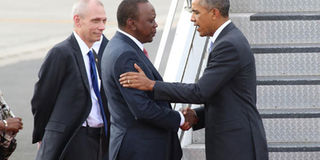Kenya is exporting innovation on its way to becoming a ‘silicon savannah’

US President Barack Obama bids farewell to counterpart Uhuru Kenyatta (L) before boarding Air Force One prior to his departure from Kenyatta International Airport in Nairobi on July 26, 2015. PHOTO JOAN PERERUAN | NATION MEDIA GROUP
What you need to know:
- Kenya, along with a small group of developing nations, holds the promise of accomplishing two aims at once: harnessing the leap-ahead power of technology and applying that force toward social progress and basic living conditions.
- his is one area where aid and development agencies such as the US Agency for International Development (USaid) and the Overseas Private Investment Corporation (Opic) can help.
Kenya now may well be on its way to becoming a “silicon savannah,” a hub of excellence and innovation in technology. Such an accomplishment would represent an enormous contribution to the rest of the world.
Kenya, along with a small group of developing nations, holds the promise of accomplishing two aims at once: harnessing the leap-ahead power of technology and applying that force toward social progress and basic living conditions. M-Pesa has become renowned worldwide. Pride and techno-optimism are well-deserved.
Yet it is important to differentiate between technologies whose efficiency transforms communications and markets and those that transform the quality of life.
In the early 20th century, the United States was a developing country. The advent of the telephone was regarded as the “acme of technological marvels” and an extraordinary driver of commerce.
By 1910, telephone usage had witnessed nearly 20-fold growth in just two decades. We still revere inventor Alexander Graham Bell.
What became of the obscure inventors, Charles Neff and Robert Frame, who worked on a public health challenge? Amid a burst of 350 patented inventions for indoor plumbing in the early 20th century, theirs became the national norm. With the adoption of their toilets, they saved perhaps hundreds of thousands of Americans from dysentery in subsequent decades.
One need not view these as either-or propositions: either Kenya invests to develop a space programme or, say, better water management. Kenya is uniquely positioned to consider both. Scientists now use satellites to measure aquifer levels and the “internet of things” allows for remote sensors to optimise use and pricing. Kenya, as a water-stressed nation, certainly has a pressing need on this front.
Already, companies such as Sanergy are blazing a path. It provides hygienic sanitation in Nairobi’s slums through an innovative toilet franchise system that generates additional income by recycling human waste to create electricity and organic fertiliser for farms. Mawingu Networks is contributing to a future of both lower carbon emissions and higher education levels by providing solar-powered wireless internet connectivity.
The challenge will be to collaborate with partners, many of whom were in Nairobi last weekend, to find the right balance of investment in the provision of basic services of health and education, strengthening of governance and institutions, and market-driven investment in leap-ahead talent and technology.
Kenya, for example, recently launched a very exciting initiative with Microsoft 4Africa to enable online patent registrations for inventors. At the same time, the nation’s ranking in intellectual property laws and enforcement is low.
One could reply that, in fairness, this is the old chicken-or-egg quandary. Technology-driven economic growth cannot zoom ahead without advanced, well-financed government agencies that are free of corruption.
But such agencies cannot be created until economic growth is capable of generating sufficient tax revenue to fund training and retain talented civil servants. This is one area where aid and development agencies such as the US Agency for International Development (USaid) and the Overseas Private Investment Corporation (Opic) can help.
Working in tandem, USaid and Opic have been able to accelerate and expand the one-two approach of providing technical assistance for government agencies in Africa, quickly followed by catalytic capital and risk management that brings in private investors. It has proven to be a highly effective formula in President Obama’s Power Africa initiative to expand energy access.
The goal, of course, is to ensure that Africa does more than catch up with others.
The goal is to give Africa every chance to lead.
“Angel investors” are just now sprouting throughout Africa. Most are city-born and city-educated, of course, and their emergence can only be regarded as good news.
Yet, we should never forget that the most brilliant potential angel investor in Africa could have been born this very morning, in a county such as Turkana or Marsabit. Let us join together to give that child every chance to help Kenya shine for the world.
The writer is the president and CEO of the US Overseas Private Investment Corporation




